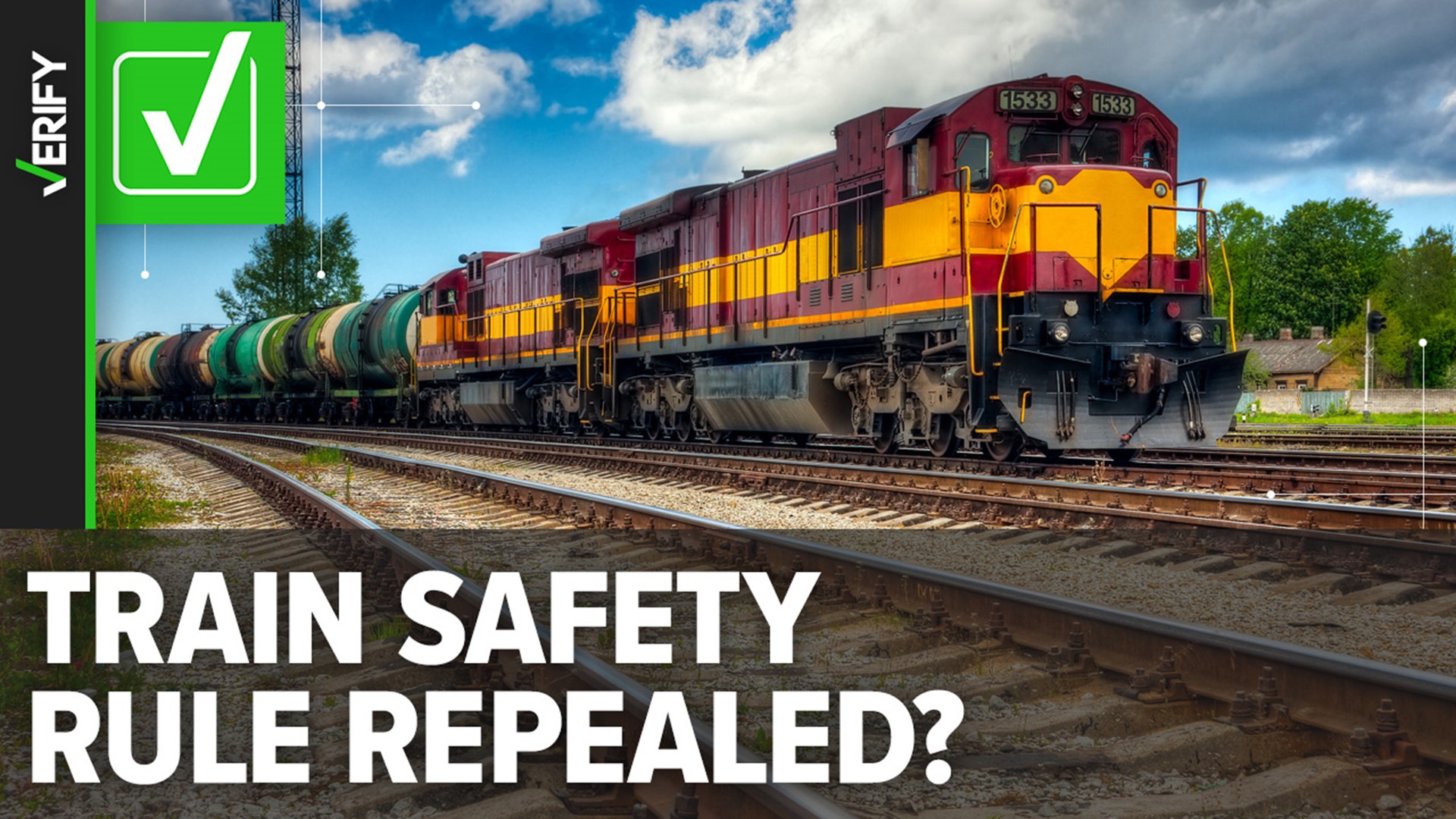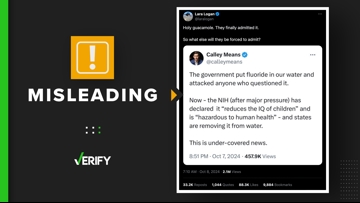On Feb. 3, nearly 50 train cars, including some carrying hazardous materials, derailed in a fiery crash in East Palestine, Ohio. Following the crash, officials conducted a controlled burn of some of the train cars to prevent a potential explosion of a toxic chemical called vinyl chloride that was onboard.
Thousands of residents had to temporarily evacuate because of health concerns related to the fumes. The cause of the derailment has not yet been determined, and an investigation is ongoing.
Over a week after the crash, U.S. Secretary of Transportation Pete Buttigieg posted a Twitter thread on the work the Department of Transportation is currently doing to make trains safer. In one of the tweets, Buttigieg claimed one rail safety regulation involving brakes was withdrawn by the Trump administration in 2018 because of a law passed by Congress in 2015. Several others on Twitter shared similar claims.
VERIFY viewer Martha recently emailed our team to ask if these claims are true.
THE QUESTION
Did the Department of Transportation repeal a train safety rule in 2018?
THE SOURCES
- Fixing America's Surface Transportation (FAST) Act
- Federal Register
- Federal Railroad Administration (FRA)
- Pipeline and Hazardous Materials Safety Administration (PHMSA)
- Government Accountability Office (GAO)
- National Transportation Safety Board (NTSB)
- Harvard University Environmental & Energy Law Program
- Sheet Metal, Air, Rail and Transportation Workers (SMART) Union
- The Railway Technical Website
- Twitter thread by Jennifer Homendy, NTSB chair
- Steven Ditmeyer, former director of research and development at the Federal Railroad Administration
THE ANSWER
Yes, the Department of Transportation repealed a train safety rule in 2018.
WHAT WE FOUND
The Department of Transportation (DOT) repealed a train safety rule in 2018 that required installing electronically controlled pneumatic (ECP) brakes on trains that carried highly flammable hazardous materials, including crude oil.
Most of the world’s trains are equipped with air-braking systems that use compressed air to stop each train car individually. ECP brakes, which use electronic signals to simultaneously apply and release brakes throughout the length of a train, were introduced to overcome the drawbacks of the air-brake system on long freight trains.
“Trains stop shorter with ECP brakes and everything is simultaneous. You don't get the big run-ins that you get with conventional air brakes,” Steven Ditmeyer, former director of research and development at the Federal Railroad Administration, told VERIFY partner station WFMY.
John Risch, the national legislative director for the Sheet Metal, Air, Rail and Transportation Workers (SMART) Union, wrote that “ECP brakes are the greatest safety advancement I have seen in my 40 years in the railroad industry.”
“ECP brakes slow and stop trains up to 70% faster than conventional brakes and are the safest, most advanced train braking system in the world,” Risch said.
In December 2015, President Barack Obama signed the Fixing America's Surface Transportation (FAST) Act into law following a number of high-profile train derailments in the U.S. and Canada.
The FAST Act included a provision that ordered the Government Accountability Office (GAO) and other researchers to review the ECP brake rule following complaints from railroad companies and lobbyists, including the Association of American Railroads.
The GAO report found flaws in the DOT’s estimates of potential business benefits of the ECP brakes, including reduced fuel consumption, reduced wear on wheels, and improved operational efficiencies. After the GAO released its findings, the DOT performed a revised cost-benefit analysis, which determined the benefits of ECP brakes did not outweigh the cost of implementing them. On Sept. 25, 2018, the DOT issued a final rule to remove the ECP brake rule from the FAST Act.
A few months after the repeal, the Associated Press released a study that found that the DOT’s analysis omitted up to $117 million in estimated future damages from train derailments that could be avoided by using electronic brakes.
As a result of the AP study, the DOT issued a technical correction in January 2019 but maintained the costs exceeded the benefits of the ECP brake rule, according to the Harvard University Environmental & Energy Law Program.
The Biden administration has not reinstated the ECP brake rule. In Buttigieg's recent Twitter thread, he implied the DOT is constrained by law from reissuing the mandate.
“I’m always ready to work with Congress on furthering (or in some cases, restoring) our capacity to address rail safety issues,” Buttigieg tweeted.
In a Feb. 14 press release, the National Transportation Safety Board (NTSB), the lead investigative agency into the Ohio train derailment, said investigators had examined the rail car that initiated the crash on Feb. 3.
“Surveillance video from a residence showed what appears to be a wheel bearing in the final stage of overheat failure moments before the derailment,” the NTSB said. The wheelset and overheated wheel bearing are currently being examined by NTSB engineers.
In an email, an NTSB spokesperson told VERIFY the train involved in the Ohio derailment was not equipped with ECP brakes. On Feb. 16, NTSB chair Jennifer Homendy addressed misinformation spreading about the derailment on Twitter.
Homendy directly acknowledged that the ECP brake rule would not have prevented the crash if implemented because the train that derailed in East Palestine was a mixed freight train that contained only three placarded Class 3 flammable liquids cars. Homendy said the ECP braking rule would have applied only to high-hazard flammable trains.
“This means even if the rule had gone into effect, this train wouldn't have had ECP brakes,” Homendy said.
The Federal Railroad Administration says it is continuing to evaluate the potential for usage of ECP brake equipment to improve railroad safety and braking performance, such as researching the potential development of other enabling technologies to support adoption.
“Pending the results of the NTSB investigation, FRA is prepared to use our full authority to ensure accountability and advance safety,” a Federal Railroad Administration spokesperson told VERIFY.












